Abstract
A series of trials was conducted in which wild-type A/USSR/90/77 (H1N1) influenza A virus and a few of its antigenic variants were inoculated into volunteers. Infections readily occurred in people of all ages who had initial low antibody titers, but clinical effects were generally mild in comparison with those of the previously tested subtypes, H0N1, H1N1, H2N2, H3N2. There was, however, an inverse relationship between severity of symptoms and age of volunteers, although the incidence of virus excretion and of increase in anti-hemagglutinin was apparently not age related. Naturally occurring recombinant viruses with H3 hemagglutinin and one or more genes of A/USSR/098/77-like strains were likewise studied in volunteers. These clones also produced mild symptoms, providing evidence of an attenuating effect on H3N2 viruses by the substitution of some of its genes with the genes of an H1N1 virus.
Full text
PDF
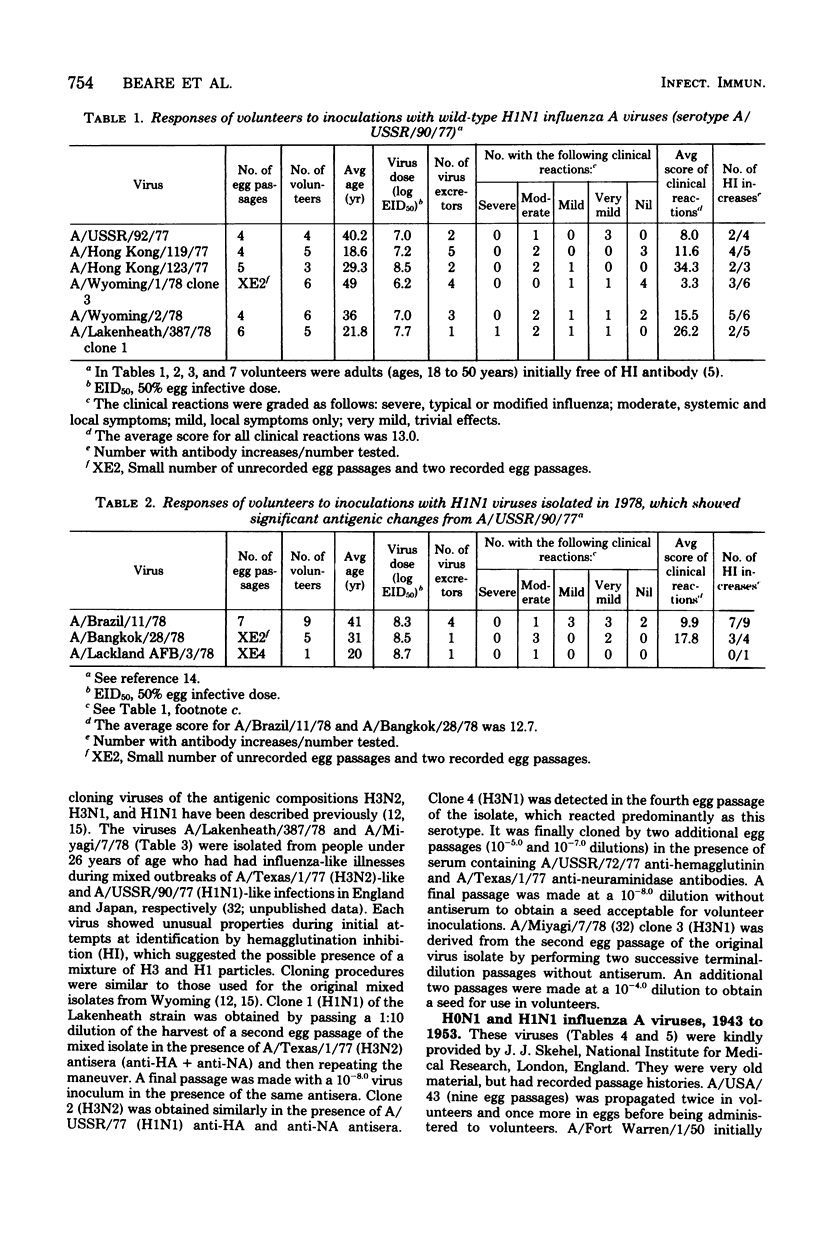
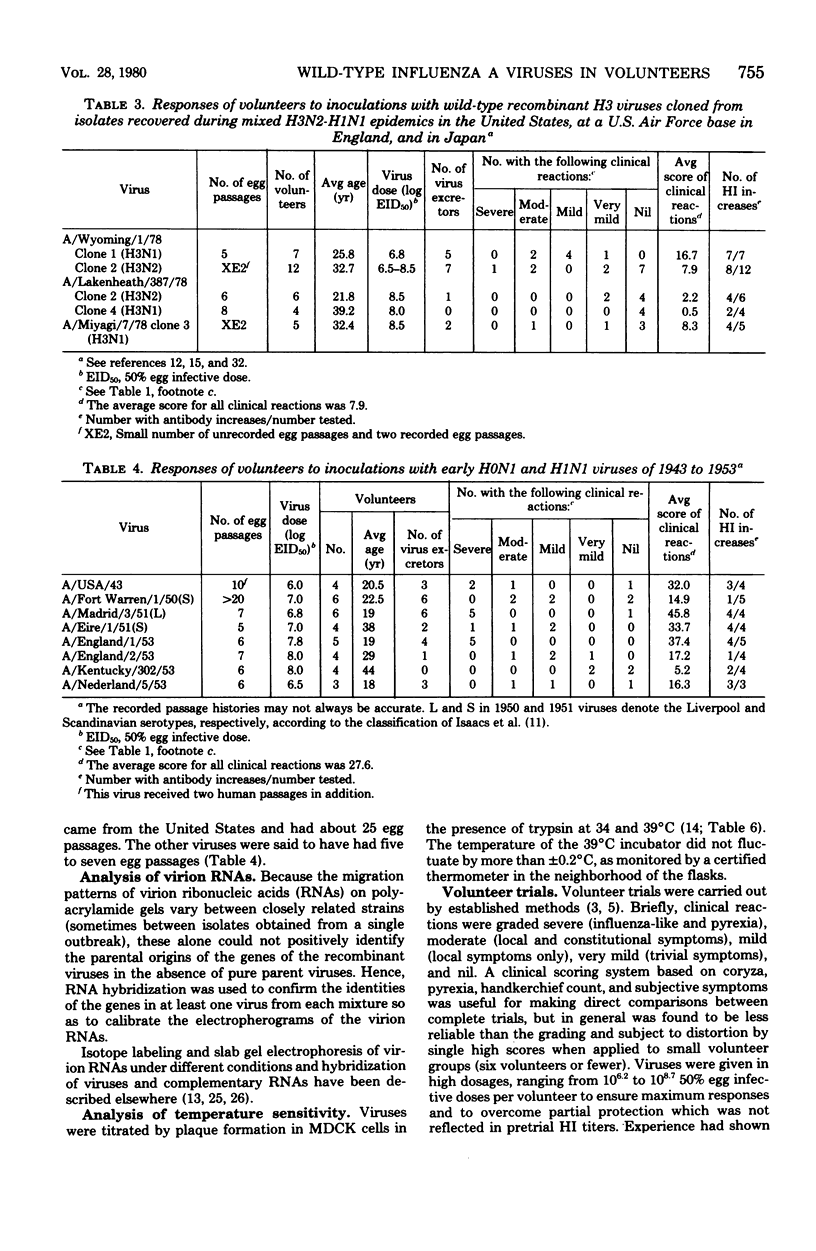
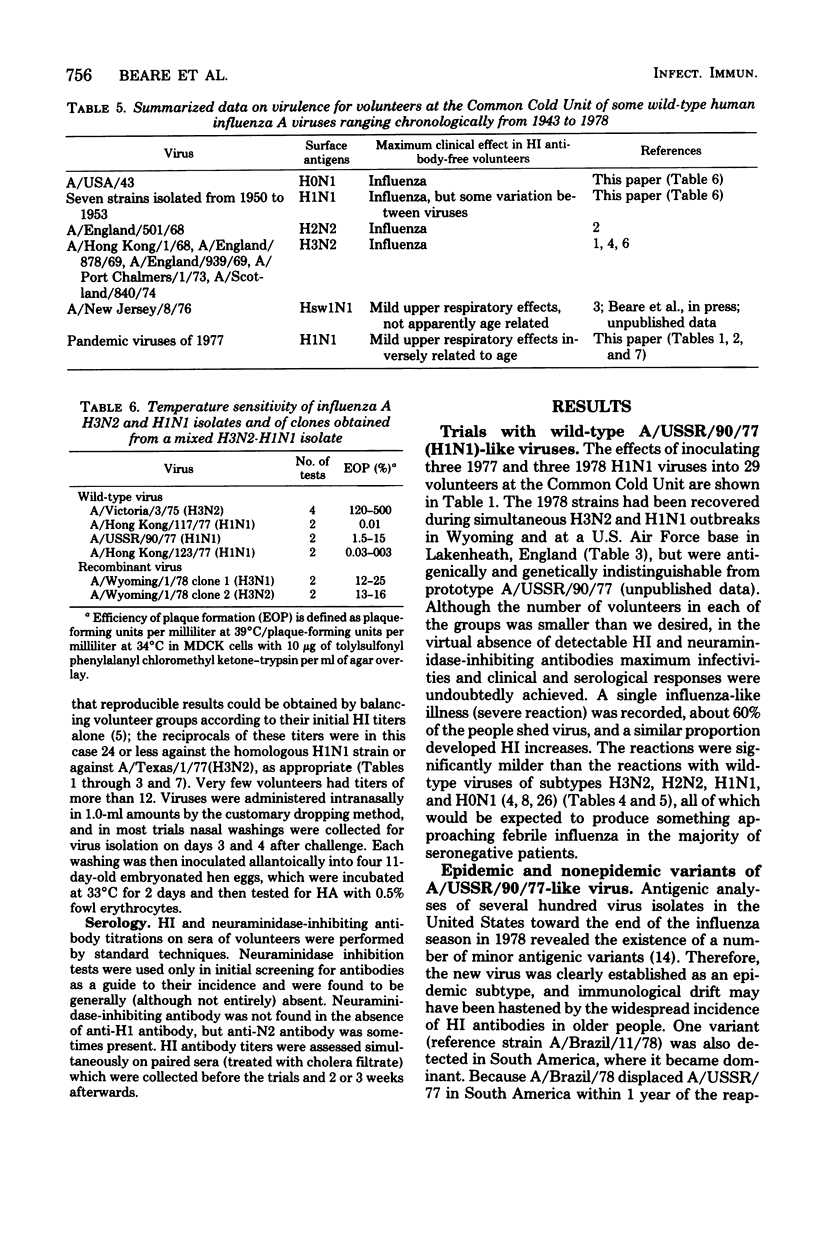
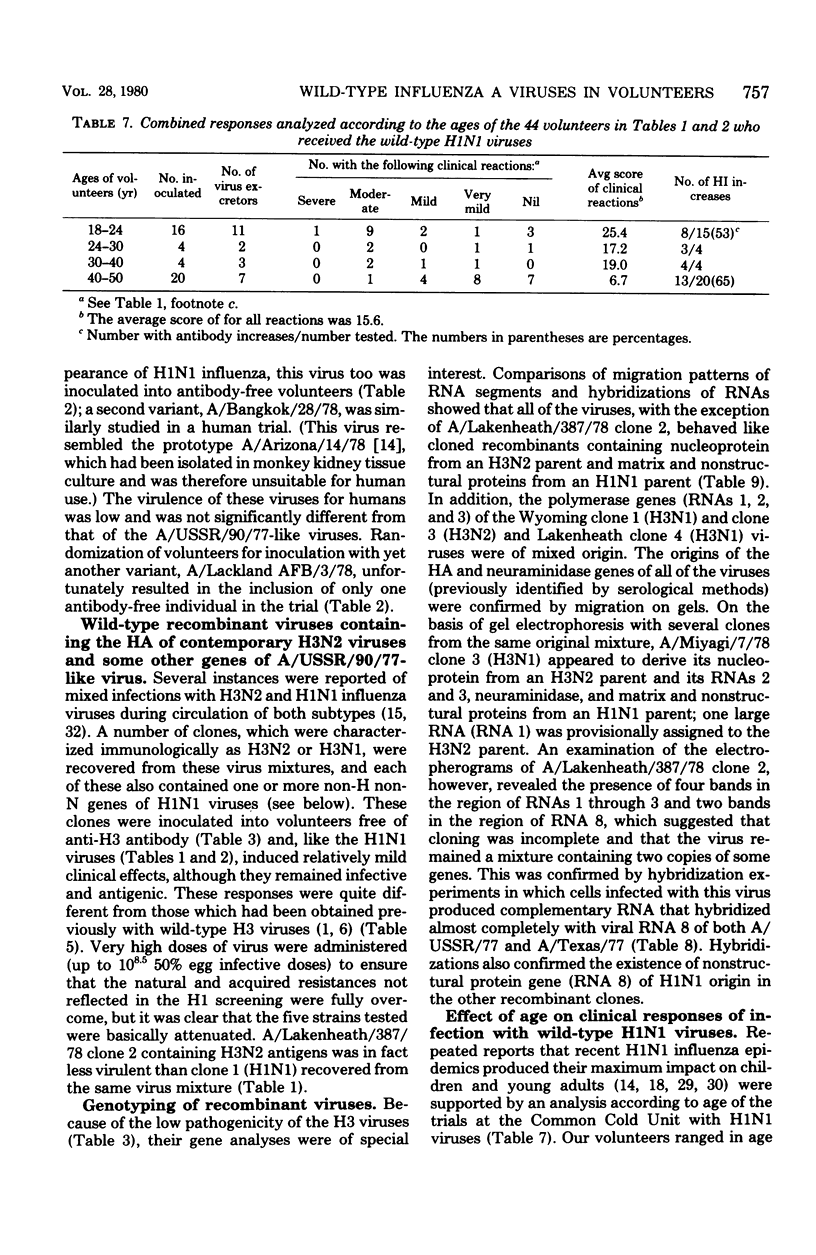
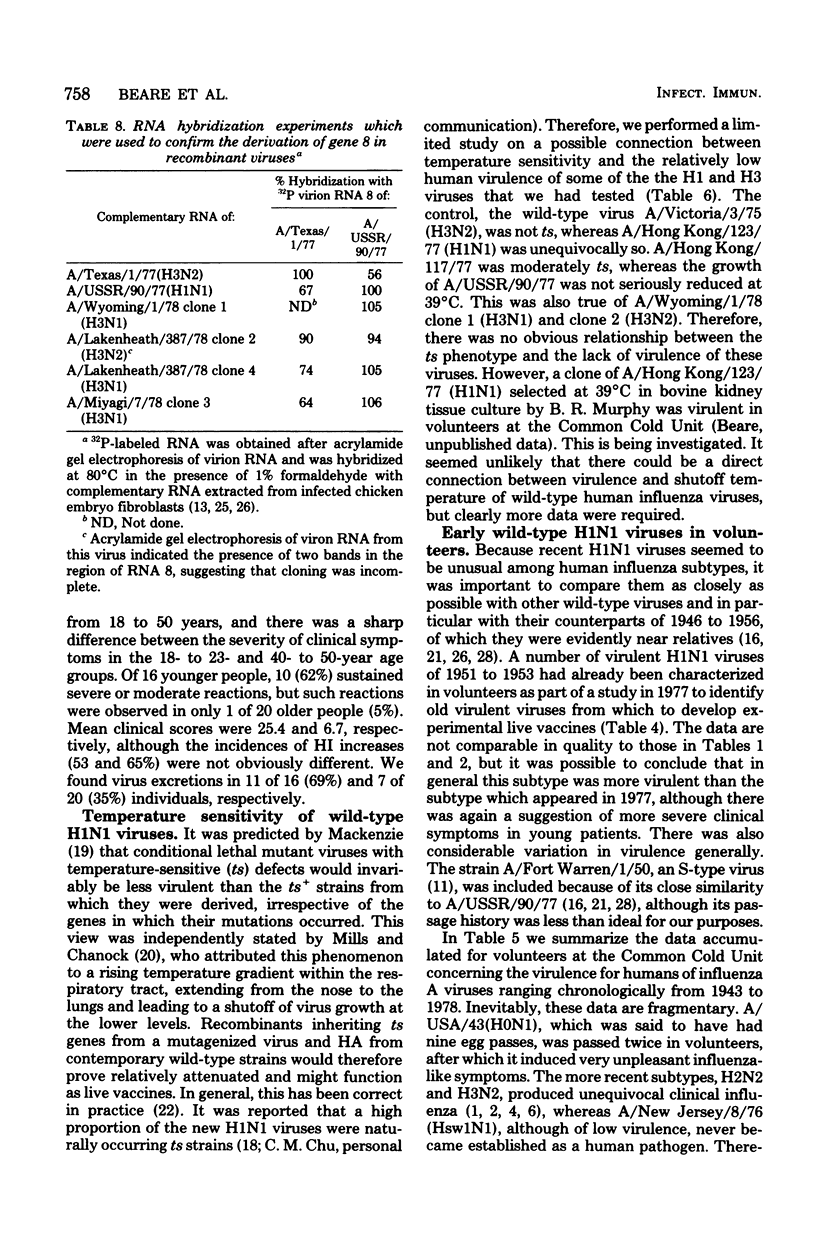
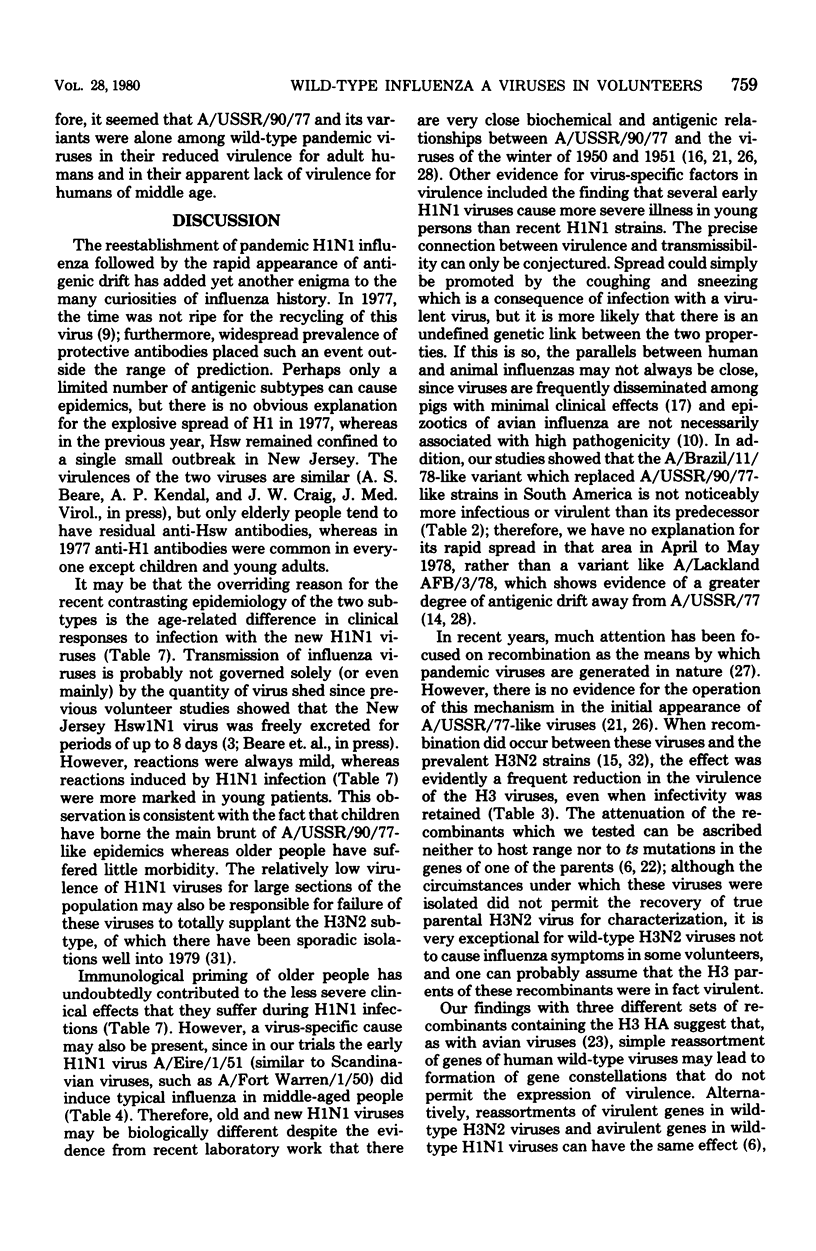
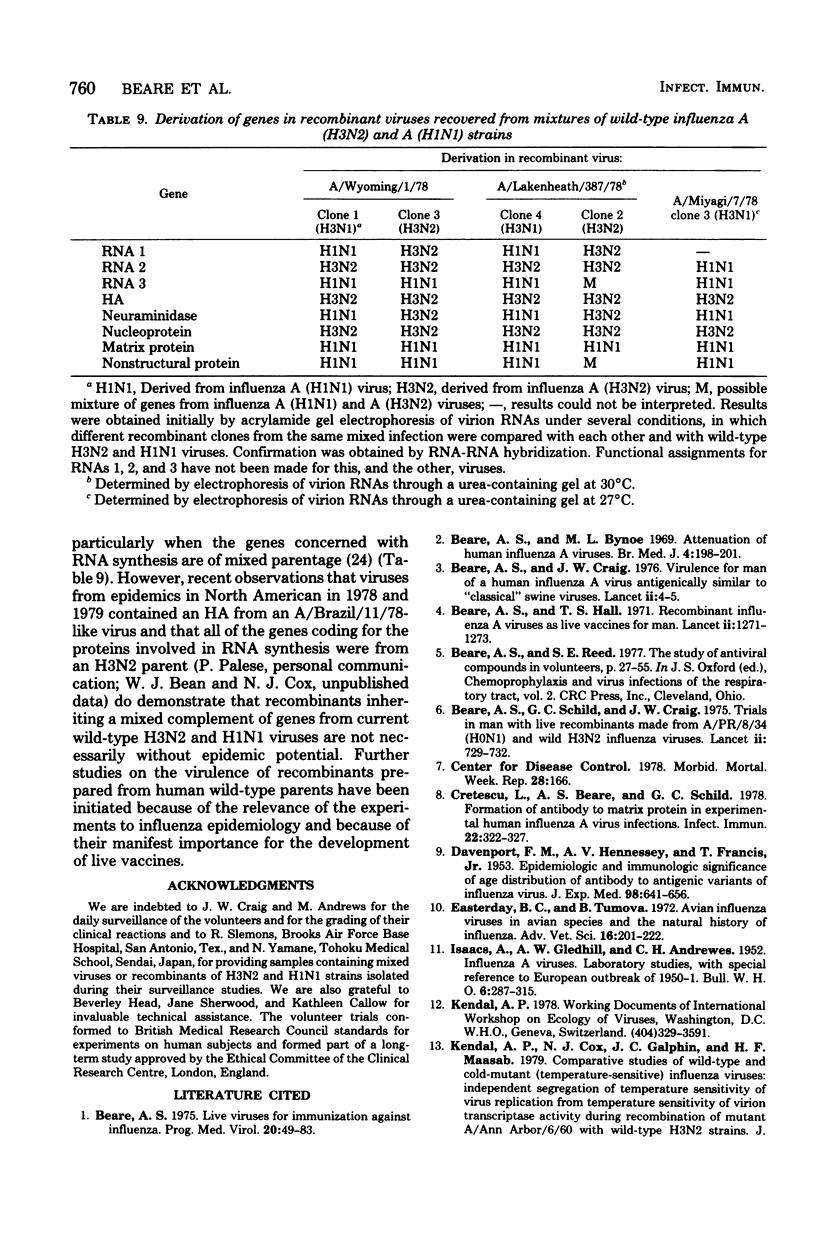
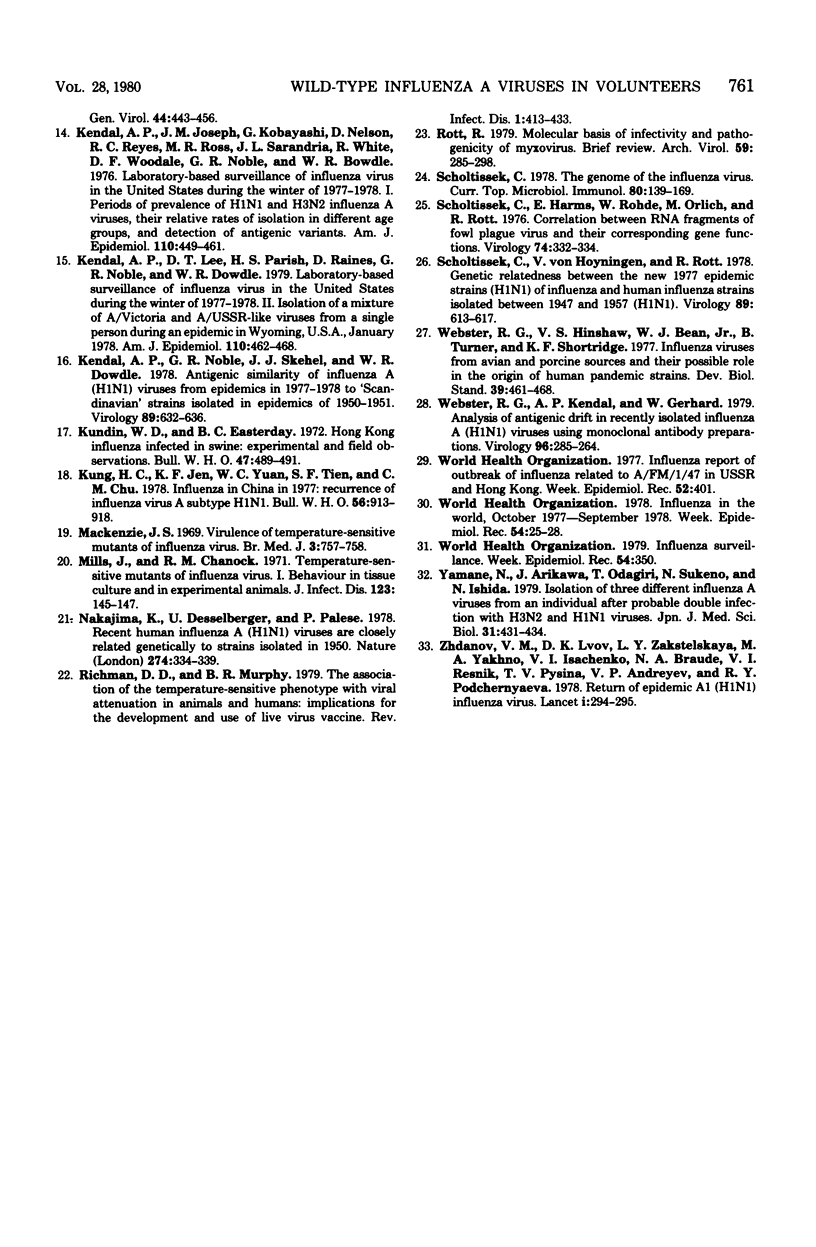
Selected References
These references are in PubMed. This may not be the complete list of references from this article.
- Beare A. S., Bynoe M. L. Attenuation of human influenza A viruses. Br Med J. 1969 Oct 25;4(5677):198–201. doi: 10.1136/bmj.4.5677.198. [DOI] [PMC free article] [PubMed] [Google Scholar]
- Beare A. S., Craig J. W. Virulence for man of a human influenza-A virus antigenically similar to "classical" swine viruses. Lancet. 1976 Jul 3;2(7975):4–5. doi: 10.1016/s0140-6736(76)92964-0. [DOI] [PubMed] [Google Scholar]
- Beare A. S., Hall T. S. Recombinant influenza-A viruses as live vaccines for man. Report to the Medical Research Council's Committee on Influenza and other Respiratory Virus Vaccines. Lancet. 1971 Dec 11;2(7737):1271–1273. doi: 10.1016/s0140-6736(71)90597-6. [DOI] [PubMed] [Google Scholar]
- Beare A. S. Live viruses for immunization against influenza. Prog Med Virol. 1975;20:49–83. [PubMed] [Google Scholar]
- Beare A. S., Schild G. C., Craig J. W. Trials in man with live recombinants made from A/PR/8/34 (H0 N1) and wild H3 N2 influenza viruses. Lancet. 1975 Oct 18;2(7938):729–732. doi: 10.1016/s0140-6736(75)90720-5. [DOI] [PubMed] [Google Scholar]
- Cretescu L., Beare A. S., Schild G. C. Formation of antibody to matrix protein in experimental human influenza A virus infections. Infect Immun. 1978 Nov;22(2):322–327. doi: 10.1128/iai.22.2.322-327.1978. [DOI] [PMC free article] [PubMed] [Google Scholar]
- DAVENPORT F. M., HENNESSY A. V., FRANCIS T., Jr Epidemiologic and immunologic significance of age distribution of antibody to antigenic variants of influenza virus. J Exp Med. 1953 Dec;98(6):641–656. doi: 10.1084/jem.98.6.641. [DOI] [PMC free article] [PubMed] [Google Scholar]
- Easterday B. C., Tumova B. Avian influenza viruses: in avian species and the natural history of influenza. Adv Vet Sci Comp Med. 1972;16:201–222. [PubMed] [Google Scholar]
- ISAACS A., GLEDHILL A. W., ANDREWES C. H. Influenza A viruses; laboratory studies, with special reference to European outbreak of 1950-1. Bull World Health Organ. 1952;6(3):287–315. [PMC free article] [PubMed] [Google Scholar]
- Kendal A. P., Joseph J. M., Kobayashi G., Nelson D., Reyes C. R., Ross M. R., Sarandria J. L., White R., Woodall D. F., Noble G. R. Laboratory-based surveillance of influenza virus in the United States during the winter of 1977-1978. I. Periods of prevalence of H1N1 and H3N2 influenza A strains, their relative rates of isolation in different age groups, and detection of antigenic variants. Am J Epidemiol. 1979 Oct;110(4):449–461. doi: 10.1093/oxfordjournals.aje.a112826. [DOI] [PubMed] [Google Scholar]
- Kendal A. P., Lee D. T., Parish H. S., Raines D., Noble G. R., Dowdle W. R. Laboratory-based surveillance of influenza virus in the United States during the winter of 1977--1978. II. Isolation of a mixture of A/Victoria- and A/USSR-like viruses from a single person during an epidemic in Wyoming, USA, January 1978. Am J Epidemiol. 1979 Oct;110(4):462–468. doi: 10.1093/oxfordjournals.aje.a112827. [DOI] [PubMed] [Google Scholar]
- Kendal A. P., Noble G. R., Skehel J. J., Dowdle W. R. Antigenic similarity of influenza A (H1N1) viruses from epidemics in 1977--1978 to "Scandinavian" strains isolated in epidemics of 1950--1951. Virology. 1978 Sep;89(2):632–636. doi: 10.1016/0042-6822(78)90207-6. [DOI] [PubMed] [Google Scholar]
- Kundin W. D., Easterday B. C. Hong Kong influenza infection in swine: experimental and field observations. Bull World Health Organ. 1972;47(4):489–491. [PMC free article] [PubMed] [Google Scholar]
- Kung H. C., Jen K. F., Yuan W. C., Tien S. F., Chu C. M. Influenza in China in 1977: recurrence of influenzavirus A subtype H1N1. Bull World Health Organ. 1978;56(6):913–918. [PMC free article] [PubMed] [Google Scholar]
- Mackenzie J. S. Virulence of temperature-sensitive mutants of influenza virus. Br Med J. 1969 Sep 27;3(5673):757–758. doi: 10.1136/bmj.3.5673.757. [DOI] [PMC free article] [PubMed] [Google Scholar]
- Mills J., Chanock V., Chanock R. M. Temperature-sensitive mutants of influenza virus. I. Behavior in tissue culture and in experimental animals. J Infect Dis. 1971 Feb;123(2):145–157. doi: 10.1093/infdis/123.2.145. [DOI] [PubMed] [Google Scholar]
- Nakajima K., Desselberger U., Palese P. Recent human influenza A (H1N1) viruses are closely related genetically to strains isolated in 1950. Nature. 1978 Jul 27;274(5669):334–339. doi: 10.1038/274334a0. [DOI] [PubMed] [Google Scholar]
- Richman D. D., Murphy B. R. The association of the temperature-sensitive phenotype with viral attenuation in animals and humans: implications for the development and use of live virus vaccines. Rev Infect Dis. 1979 May-Jun;1(3):413–433. doi: 10.1093/clinids/1.3.413. [DOI] [PubMed] [Google Scholar]
- Rott R. Molecular basis of infectivity and pathogenicity of myxovirus. Brief review. Arch Virol. 1979;59(4):285–298. doi: 10.1007/BF01317469. [DOI] [PubMed] [Google Scholar]
- Scholtissek C., Harms E., Rohde W., Orlich M., Rott R. Correlation between RNA fragments of fowl plague virus and their corresponding gene functions. Virology. 1976 Oct 15;74(2):332–344. doi: 10.1016/0042-6822(76)90340-8. [DOI] [PubMed] [Google Scholar]
- Scholtissek C. The genome of the influenza virus. Curr Top Microbiol Immunol. 1978;80:139–169. doi: 10.1007/978-3-642-66956-9_5. [DOI] [PubMed] [Google Scholar]
- Scholtissek C., von Hoyningen V., Rott R. Genetic relatedness between the new 1977 epidemic strains (H1N1) of influenza and human influenza strains isolated between 1947 and 1957 (H1N1). Virology. 1978 Sep;89(2):613–617. doi: 10.1016/0042-6822(78)90203-9. [DOI] [PubMed] [Google Scholar]
- Webster R. G., Hinshaw V. S., Bean W. J., Jr, Turner B., Shortridge K. F. Influenza viruses from avian and porcine sources and their possible role in the origin of human pandemic strains. Dev Biol Stand. 1977 Jun 1;39:461–468. [PubMed] [Google Scholar]
- Webster R. G., Kendal A. P., Gerhard W. Analysis of antigenic drift in recently isolated influenza A (H1N1) viruses using monoclonal antibody preparations. Virology. 1979 Jul 15;96(1):258–264. doi: 10.1016/0042-6822(79)90189-2. [DOI] [PubMed] [Google Scholar]
- Yamane N., Arikawa J., Odagiri T., Sukeno N., Ishida N. Isolation of three different influenza A viruses from an individual after probable double infection with H3N2 and H1N1 viruses. Jpn J Med Sci Biol. 1978 Oct-Dec;31(5-6):431–434. doi: 10.7883/yoken1952.31.431. [DOI] [PubMed] [Google Scholar]
- Zhdanov V. M., Lvov D. K., Zakstelskaya L. Y., Yakhno M. A., Isachenko V. I., Braude N. A., Reznik V. I., Pysina T. V., Andreyev V. P., Podchernyaeva R. Y. Return of epidemic A1 (H1N1) influenza virus. Lancet. 1978 Feb 11;1(8059):294–295. doi: 10.1016/s0140-6736(78)90068-5. [DOI] [PubMed] [Google Scholar]


